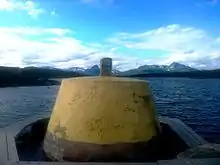Three-Country Cairn
Three-Country Cairn (Finnish: Kolmen valtakunnan rajapyykki, Northern Sami: Golmma riikka urna, Norwegian: Treriksrøysa, Swedish: Treriksröset) is the point at which the international borders of Sweden, Norway and Finland meet, and the name of the monument that marks the point. It is an example of a geographical feature known as a tripoint. It is the northernmost international tripoint in the world.
| Kolmen valtakunnan rajapyykki (Finnish) Golmma riikka urna (Northern Sami) Treriksrøysa (Norwegian) Treriksröset (Swedish) | |
 The cairn in 2014 | |
| Coordinates | 69°03′35.9″N 20°32′55.1″E |
|---|---|
| Material | Concrete frustum |
| Completion date | 1926 |
| Dedicated to | Marking the tripoint of the borders of Norway, Sweden and Finland |

The border between Norway and Sweden including Finland was decided in Stromstad Treaty of 1751 and marked with cairns the following years, including cairn 294 which is located on a hill 150 meters east of today's Three-Country Cairn. When Sweden ceded Finland to Russia in 1809, it was decided that the new Finland–Sweden border should follow the rivers. The place where the river (actually in a lake) crossed the old border had no mark for several years. A monument of stones was erected on the site in 1897 by the governments of Norway and Russia (which was administering Finland at the time). The Swedish could not agree on a boundary commission with the Norwegians and did not contribute their stone until 1901. This is Sweden's most northerly point and it is the westernmost point of the Finnish mainland (the most westerly point of Finland is on the island Märket).
The current tripoint monument was built in 1926 and is a beige, conical frustum made of concrete, located about 10 metres (33 ft) out in Lake Goldajärvi (also known as Koltajärvi in Finnish, Golddajávri in Sami or Koltajaure in Sweden). It is located at 489 metres (1,604 ft) above sea level. The size is about 14 square metres (150 sq ft) with diameter of about 4 metres (13 ft). As an artificial island, it is sometimes mentioned as the world's smallest island divided by a border. This is a matter of definition. For example, in Haparanda/Tornio there are poles in water marking the border.
It may be reached by walking 11 kilometres (6.8 mi) from Kilpisjärvi in Finland along a hiking trail in the Malla Strict Nature Reserve. In summertime, it can be reached by boat from Kilpisjärvi plus a 3-kilometre (1.9 mi) walk.[1]
Climate
| Climate data for Treriksröset | |||||||||||||
|---|---|---|---|---|---|---|---|---|---|---|---|---|---|
| Month | Jan | Feb | Mar | Apr | May | Jun | Jul | Aug | Sep | Oct | Nov | Dec | Year |
| Average high °C (°F) | −9 (16) |
−9 (16) |
−4 (25) |
−2 (28) |
4 (39) |
10 (50) |
12 (54) |
12 (54) |
6 (43) |
−1 (30) |
−4 (25) |
−7 (19) |
0.7 (33.3) |
| Average low °C (°F) | −20 (−4) |
−20 (−4) |
−16 (3) |
−7 (19) |
−2 (28) |
4 (39) |
7 (45) |
4 (39) |
0 (32) |
−5 (23) |
−12 (10) |
−18 (0) |
−7.1 (19.2) |
| Source: SMHI.se[2] | |||||||||||||
See also
| Wikimedia Commons has media related to Tripoint Norway Sweden Finland. |
- Treriksrøysa – a cairn that marks the tripoint where the borders of Norway, Finland, and Russia meet.
References
- "Treriksröset" (in Swedish). Karesuando.se. Retrieved 11 April 2010.
- "Weather Information for Treriksröset 1961–1990". Swedish Meteorological Institute. Retrieved 1 November 2012.